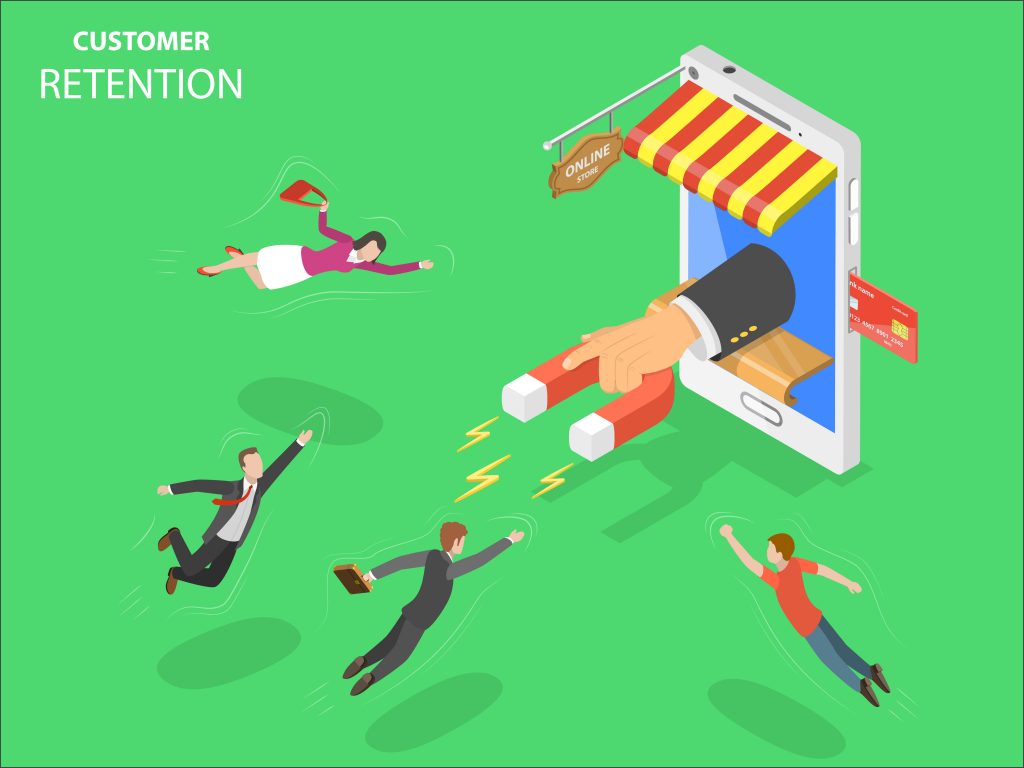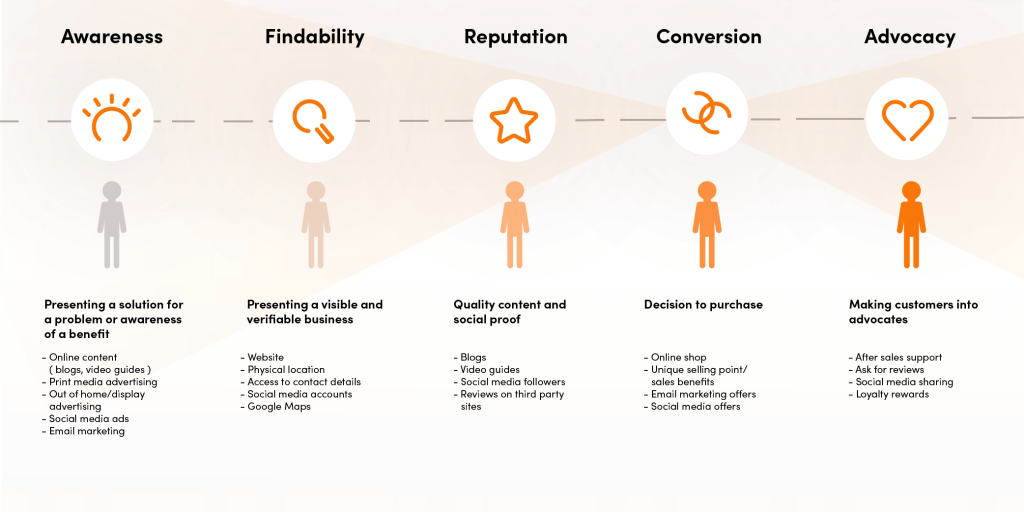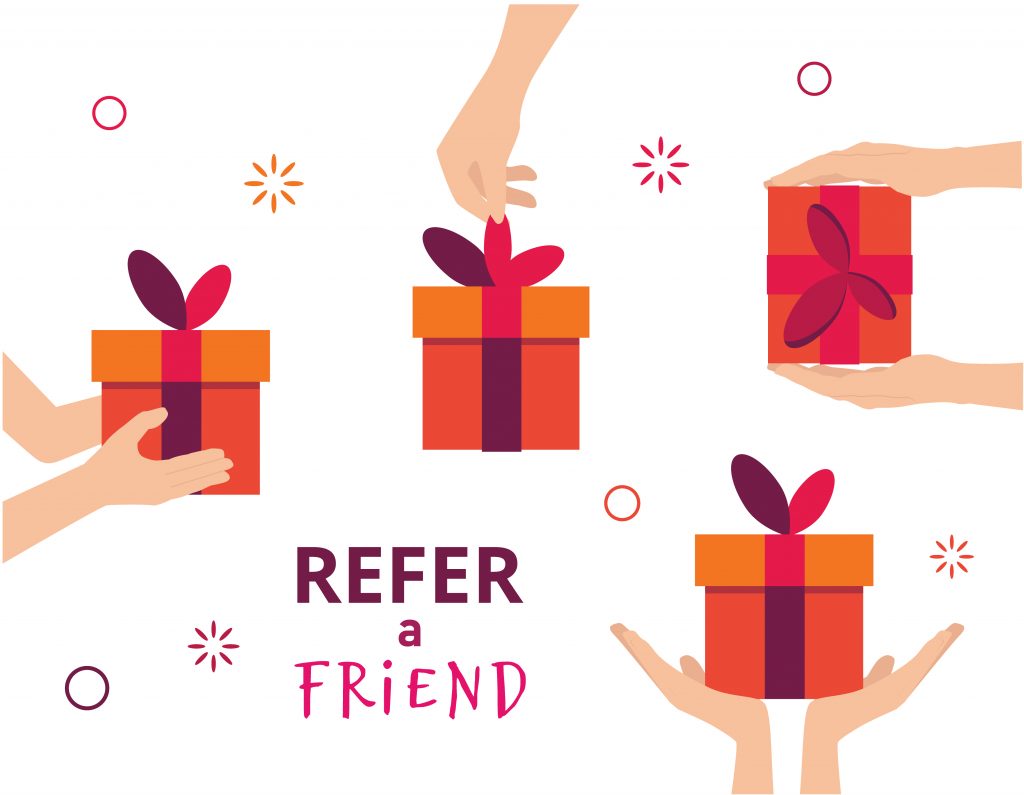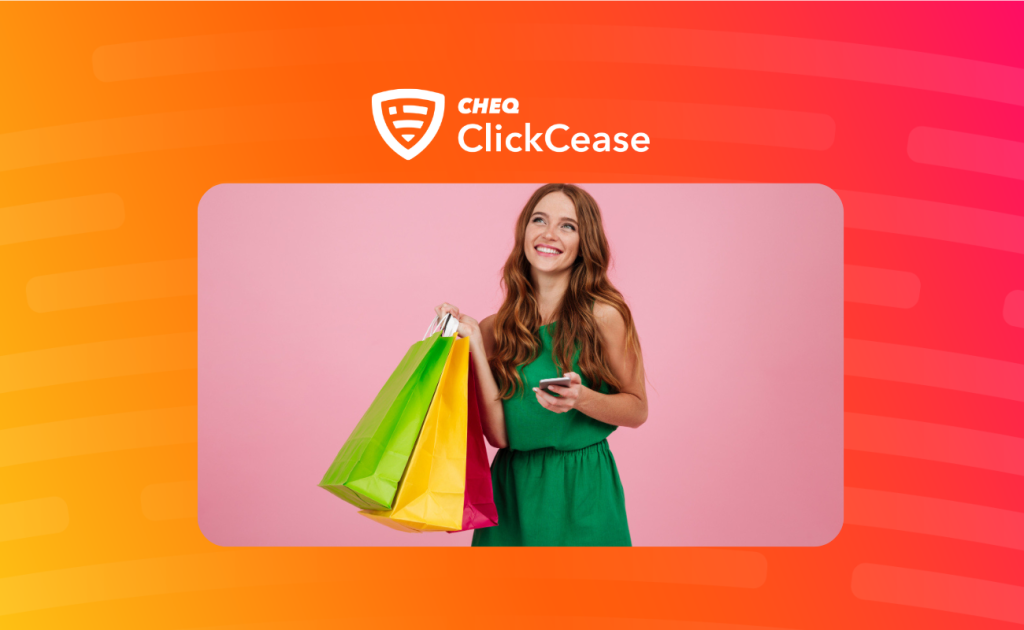Building a new business, or improving an existing one? Aiming to maximise your company profits this year? Wondering how you can scale up your business and open those franchises you’ve been planning? Or just want to make more website sales?
Then you’ll need to get familiar with customer acquisition strategy.
Getting and keeping customers is, obviously, the foundation for most businesses. But in the era of digital marketing, there is more to it than simply opening up shop and waiting for the stampede.
What is customer acquisition?
Customer acquisition strategy, sometimes referred to as CAS, is the art and science of winning new customers.
By targeting your target demographic and bringing them into your marketing funnel, you can increase the chances of them converting to being your customer, as opposed to going to a competitor.
Digital marketing is probably the number one way for most businesses to win new customers in the modern era, with search and social media marketing at the top of most people’s customer acquisition strategy lists.
However, customer acquisition is generally a fairly holistic practice. The era of bombarding the populace with ads, although still effective in its own way, is mostly behind us.
Modern marketers rely on a broad suite of marketing approaches to maximise the chances of winning new customers – and retaining old ones.
Customer acquisition channels
Digital marketing is a broad sector, so understanding the different channels is key to CAS success.
The challenge with customer acquisition is to be visible at various stages of the marketing funnel. This includes both online and offline marketing strategies and understanding the journey your average customer takes to go from casual interest to confirmed purchase.
Marketing campaigns will normally include a mix of the following:
- Paid search ads
- Display advertising
- Social media ads and organic posts
- Video content and video ads
- Email marketing
- Influencer and affiliate marketing
- Organic reviews
- Content marketing (blogs and guides)
- Offline marketing including print, TV, radio, and display
There is a time and a place for all of these throughout the customer journey. However, not every business will have the capacity, or even the need, to use all of these CAS options.
So how can the average SME, one without a bottomless marketing budget, apply these strategies to snare new buyers and visitors?
From awareness through to the decision stages, there are a number of ways your business can stand out.

How do businesses win more new customers?
It used to be a case of popping an ad out there in the real world, and then waiting for the customers to come. Running a newspaper ad campaign, or – if you really had the money – TV ads, was a surefire way to up your brand exposure and get more sales.
Today’s consumer is much more marketing savvy and relies on internet-based research to find their ideal product. We’re also much more aware of ‘being marketed to’ and so we are naturally wary of ad saturation or bad ad targeting.
With so much competition, finding ‘the right’ product for many means browsing reviews, researching comparisons, watching YouTube videos, spotting an influencer trialing a project, or any other multitude of potential online engagements.
The marketing funnel is one visualisation of the customer journey. But some prefer to imagine the customer journey less as a funnel, and more as a path or a cycle.
How you visualise the customer journey isn’t important. But understanding the journey is crucial.

The image above is probably familiar to all marketers. In fact, the customer journey is something that most of us understand, even if we’re not expert marketers.
You might also see references to the customer life cycle, and how to maximise this.
Both the journey and the customer life cycle are crucial elements in the entire CAS canon, and in fact one feeds into the other. So, we’ll take a look at the two within this post and how they work together.
First, though, we’ll take a look at how you can use a strategy to improve your customer acquisition.
Customer acquisition strategy
Winning new customers means you need to do three things:
- Get people’s attention
- Win their trust
- Convince them to buy from YOU
This is a simplified way of looking at the overall customer journey chart. But, to look in more depth at each step.
Awareness/attention
People might already be aware of their need for a particular service. Products like food, vacations, clothing and business services are the kind of things that we all consume as standard, so little is needed in the way of bringing attention to the matter.
But it can be hard to stand out in an ocean of competition. And this can be where the challenge of building a customer acquisition strategy lies.
- Educating & informing
For more niche concerns it is often a case of education. Here at ClickCease, for example, we offer a solution to a problem that many marketers are either unaware of or unconcerned by. So, much of our marketing is directed to raising awareness of the problem and educating our audience. This includes a combination of paid advertising on multiple channels and offering free information (ahem, a bit like this article).
- Paid promo!
When it comes to more saturated markets, for example a new clothing brand or a software product such as a game, there is no real substitute for targeted marketing. Like any industry, you do need to understand where people are looking for their information. Researching your target demographic is essential to effective targeting, which we’ve looked at in-depth before. But promoting with social media ads, YouTube videos, display banners and influencer marketing can all be a good way to make your brand stand out.
- Stand out on social media
Social media commands so much of our attention, making it an invaluable platform for generating interest and awareness in new brands. This is especially true if your product relies on triggering the ‘I want one of those’ response. In fact around half of all internet users use social media for brand research and to find new products. (source) And this is why social media is an increasingly important factor in customer acquisition strategy.
Building trust
Every industry has competition. If your industry doesn’t then, well, lucky you…
But in general, the trick to standing out from the competition is having ‘verifiable’ proof that you’re better than the rest. How do you do this?
- Review sites
Sites like TrustPilot, Google, Amazon, Capterra, TripAdvisor, Yelp and G2 are all used regularly by customers to check if a product is worth their money. You’re probably the same right? Courting good responses from existing customers, and handling objections properly can all contribute to building trust.
And don’t worry if your rating isn’t a perfect 5. Apparently, we’re more likely to trust a rating between 4.2 – 4.5 instead of full marks.
- Blogs and influencers
Did you know that 87% of people read reviews before making a purchase? This includes full product reviews by trusted websites or social media influencers. Put simply, you want to make sure that if people are searching for reviews of your product, they find plenty to sink their teeth into. This also explains the rise in affiliate marketing and influencers.
If you’re looking to improve your customer acquisition then a focus on external reviews can be a huge boost to your funnel performance.
- Word of mouth
As we’ll see, advocacy is an important step in the long term customer lifecycle and a businesses CAS. Happy customers will come back, will leave good reviews and are more likely to tell other people about their positive experience. Having a strategy to fix problems with existing customers, and to make people genuine advocates of your service needs to be factored in for long term customer success.
The conversion
It all comes down to this. The sale. The conversion. Parting your target demographic willingly from their hard earned cash and bringing them into the fold.
So how can you do this more effectively?
As always, there is no blanket answer and it will depend greatly on your industry, your product and other factors such as timing, price and demand.
Some general tips for improving your conversions include:
- Consistency with your marketing
Be visible at different stages of the customer journey and make yourself especially visible at the decision end. This might mean using retargeting campaigns within Google Ads or Facebook Ads.
- Use email marketing
Email lists are a valuable source of potential customers. They’ve already shown interest in your brand, and should, in theory, be open to spending money with you. Creating an email strategy, using newsletters, offers, updates or whatever other relevant information your customers might be interested in can net you a good conversion rate. Be careful though of falling into the trap of spamming people’s inboxes and losing subscribers.
- CTA’s and targeted ads
There is no getting around it. Targeting the customer with ads at the decision stage is a solid strategy. And a strong call to action, or even an incentive such as discount or limited offer, can be the difference between you and the competition.
Understanding how to word an ad, and using a good landing page, can also make the difference. Check out our guides to power words – essential for CTAs – and our guides to writing effective ad copy.
- An offer they can’t refuse…
In theory, your customer has visited you multiple times on their journey to making a purchase. So by now, they are familiar with your brand, they trust (or are at least open to trusting) your product and when it comes to the crunch they are swayed by your superior offering, whatever that may be.
But sometimes a nudge is needed. This is often something like a discount, a free add-on, or other form of added value.
Software and non-tangible products and services often hook in customers with a free trial, discounted entry offer or freemium subscriber model.
Companies dealing with tangible products might look at offering free shipping, free returns or limited discounts. It’s all about finding a way to get an edge on the competition.
The journey to brand advocate
A bonus step here…
Part of the customer journey, and of your general customer acquisition strategy, is making sure the customer is delighted with your service. So much so that they would happily come back and use it again or, better still, they’d tell all their friends.
Getting love from your customers is what you do already, surely… You provide a top quality product, exceptional customer service and great value, don’t you? Of course you do.
Offering after sales support to handle problems and objections will help to minimise dissatisfaction.
Being responsive is also one of the most important factors in customer satisfaction. People don’t want to wait days for you to reply to their email – in fact if they have to wait more than 30 minutes their satisfaction starts to plummet.
Give people less chances to dislike you, more reasons to love you, even if your service wasn’t for them, and watch your brand advocacy grow.
Customer Acquisition Cost
How much does it cost for your company to win one new customer?
This is known as customer acquisition cost (CAC), and knowing how much your CAC is can help you with your marketing strategy, your budget planning and general understanding of your company.
So how do you measure your customer acquisition cost?

Customer acquisition cost formula
There are a couple of different ways to work out your CAC. The first looks at the basics of your marketing budget against the amount of new customers acquired.
The CAC formula looks like this:
Marketing costs / Customers acquired = CAC
For example, keeping it simple, you’d look at your Google Ads spend in a month and divide that by conversions.
$5,000 Google Ads budget / 600 new customers = $8.33 per new customer
However, another way to look at your CAC formula is to include a comprehensive list of marketing based expenses against your customer acquisition.
After all, your entire business depends on new customers and sales in general. So having this priced in can also be extremely useful.
With that in mind, a more comprehensive CAC formula would include expenses such as:
- Marketing software (Ahrefs, SEM Rush, ClickCease etc)
- Marketing department wages
- Equipment costs and sundries
- Additional services (such as external consultants)
- Overheads costs
Adding these to your ad spend will obviously greatly increase your cost per customer acquisition. But this will be a more comprehensive indication of your marketing expenses.
How to reduce your customer acquisition cost
We all want more from our money, including more customers. It would be great if everyone who bought from us was an organic sale… Let’s be honest though, spending on digital advertising is an important part of modern marketing.
So how can you reduce your overall CAC and acquire more customers for less marketing spend?
We’ve taken a look on this blog before at the many different ways to improve sales and optimise your marketing spend. And many of these can also affect your customer acquisition strategy and costs.
Here are the methods that we think are best to bag more new customers.
- Use Google Ads extensions – They add essential extra elements to your ads, and can greatly improve conversions. (Read more about using Google Ads extensions here)
- Optimise your ad copy – Your ad text makes a huge difference to your clicks and can affect your customer acquisition too. Read up on content for Google Ads and understand how power words affect your copy.
- Give customers more of what they want – Often the difference between one business and another is a unique offer. Discounts, free shipping, added extras, or better after-sales support can win more new customers.
- Leverage the power of search intent – The language used at different stages of the customer journey changes. Understand how people use different search terms at different stages and optimise for this. (Read more about search intent here)
- Work on your quality score in Google Ads – A good quality score can lower your cost per click (CPC) and improve ad placement. (Read more about quality score here)
- Optimise ad targeting by time/day – Known as dayparting, running your ads at optimal times has been shown to save ad spend and improve conversions. (Read more about dayparting here)
- Block bad traffic – 1 in 4 clicks on ads come from non-genuine traffic such as bots or click farms. Blocking invalid traffic (IVT) has been shown to reduce your ad spend and improve new customer acquisition. (Read more about click fraud here)
Customer journey vs customer lifecycle
From the initial awareness of a problem that needs solving, to final purchase, the customer journey is relatively simple. But the customer lifecycle extends this journey and, hopefully, results in a happy customer who will purchase from you repeatedly in future.
In fact, we’ve looked at customer lifetime value (CLV) before.
In some industries, the customer lifecycle is related to the value or the needs of the product that they’ve purchased.
An example of customer lifecycle
A car purchase is a good example of a high end customer journey with a lifecycle to match.
As a high value item, potential customers are naturally going to weigh up the pros and cons of their desired car model. They might then visit a local dealer to take a test drive, and they might also read reviews and feedback online before they drive off the forecourt with their new wheels.
But, of course, their purchase doesn’t stop with the car. The customer is going to need replacement wiper blades, tyres, A/C servicing, roof mounts, air fresheners and an endless parade of extras during their ownership of the vehicle,

It’s relatively easy to define both the journey and the lifecycle here.
So how does this apply to a less expensive and perhaps less essential purchase?
Expanding the customer lifecycle
For some products and services, we purchase them occasionally, and we want to know we’re going to get what we want, at a good price. Things like sportswear and accessories are a good example.
If you take up a new sport such as jogging, you might get through one pair of sneakers each year. So, you might go to your local sports shop, or search online for the best deal on your favourite brand.
But, in the meantime, you might also want to pick up a running bottle, sweatbands, a running shirt, knee supports, or even a sports tracker. Many of these are not essential purchases, but if you see a nice deal on a set of branded sweatbands, hey maybe you’ll impulse purchase them. Especially if the promotion is from a store you trust and bought from before.
Mostly, this kind of promotion will be done through email marketing. However, there are also ways to promote these deals with paid advertising, using retargeting or remarketing.
Google Ads and Facebook Ads allow you to target previous customers specifically, with targeted sponsored ads.
And the benefit of running this kind of retargeting campaign is that you know that your target audience is happy to buy from you. After all, they’ve done it before.
So customer acquisition doesn’t stop at winning new customers. Giving them a reason to come back, and reminding them of your quality service and the value you provided can keep people coming back for longer than the life of the product they bought from you.
Winning advocates
Positive word of mouth is probably one of the best forms of advertising. It is, after all, completely free. And with a happy customer singing your praises to their peers, you’ve got a powerful form of social proof that can be more valuable than running paid ads even.
So how do you get here?
How can you get those glowing organic reviews on TrustPilot and social media?
- Provide a top-level service – Of course, right?
- Give great after-sales support – Show people how to get the most from your service for free. Onboarding, how-to-guides and on-hand customer support are all key elements here
- Responsive problem-solving – Handle objections and problems as quickly as possible
- Make the customer feel valued – Money off next purchase? A ‘thanks for your custom’ insert? Referral bonus? Exclusive invite for buyers?
- Ask for feedback – By making people reflect on your product/service you’re encouraging them to think about you…!
- Engage on social media – People love to engage with brands on social media. If you’re tagged/mentioned, make sure to comment back/repost and generally share the love
- Reward loyalty – Collecting points, free extras, and upgrades are all great add-ons that can sweeten the return
- Showcase positive reviews and testimonials – Highlighting the love you get inspires trust in your brand from both new and existing customers

Applying CAS to your business
Customer acquisition is a multi-layered and multi-channel strategy. There is no one size fits all guide to winning new customers, even within the same industry.
What works for your competitor, might not necessarily work for you.
So, it’s best to focus on being the best you can be and offering exceptional service. Looking at the competition is natural, but we don’t always need to try and beat them at what they’re doing. If they zig, you might try and zag instead.
To simplify a strategy to acquire new customers, we can summarize it like this:
- Identify your target audience, build avatars and try to understand their pain points and how you are going to solve their problems
- Understand how you can be visible at different stages of the customer journey. Use paid ads, search engine optimisation (SEO), social media, and the many channels at your disposal as necessary
- Give plenty of information for your potential new customers, from blogs, free guides, and video info, to reviews and testimonials
- Give customers a reason to choose your business instead of the competition. Find your USP
- Make customers so happy with your service that they will want to shout about it from the digital rooftops… or at least TrustPilot…
And that is our guide to customer acquisition.
If you’ve found this guide useful, please do let us know in the comments below.
And, if you’re running paid ads, don’t forget to block invalid traffic with ClickCease. This is a surefire way to increase your ad targeting, reduce your ad spend, and convert more customers.
